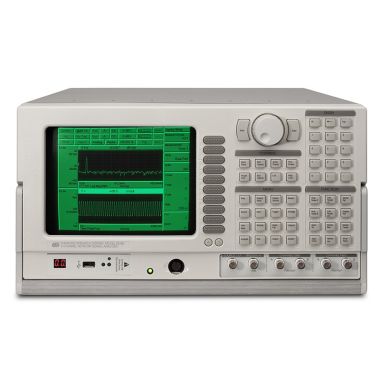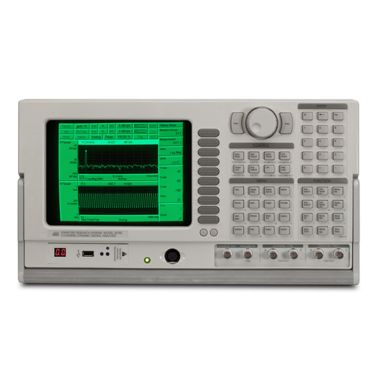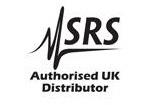SRS SR770 FFT Spectrum Analyser
- DC to 100 kHz bandwidth
- 90 dB dynamic range
- 16-bit A/D conversion
- Harmonic, band and sideband analysis
- 100 kHz real time bandwidth
- Internal and external triggering
- Linear and exponential averaging
- Hardcopy output to printers and plotters
- 3.5 inch MS-DOS compatible disk drive
- GPIB and RS-232 interfaces included
Lambda Exclusive Promotion:
Additional 12 months warranty for free (2 years total) via our UK Service Centre.
The Stanford Research Systems (SRS) SR760 and SR770 are single channel, 100 kHz FFT Spectrum Analysers with a dynamic range of 90 dB and a real-time bandwidth of 100 kHz. The SR770 additionally includes a low distortion synthesized source allowing you to measure the transfer functions of electronic and mechanical systems. The speed and dynamic range of these instruments, coupled with their flexibility and many analysis modes, make them the ideal choice for a variety of applications including acoustics, vibration, noise measurement, and general electronic use.
Features
The SRS SR760 and SRS SR770 have a true dynamic range of 90 dB. This means that for a full scale input signal the instruments have no spurious responses larger than -90 dBc (1 part in 30,000). Even signals as small as -114 dBc (1 part in 500,000) may be observed by using averaging. The low front end noise and low harmonic distortion allow you to see signals that are buried in the noise of other analyzers.
The SR760 and SR770 use a pair of high-speed 24-bit digital signal processors (DSP's) to filter, heterodyne, and transform sampled data from its 16-bit analog-to-digital converter. These DSP's can perform 25 million24-bit multiplications and additions each second. This enormous computing capability allows the analysers to operate at a real-time bandwidth of 100kHz. In other words, the SR760 and SR770 process the input signal with no dead time. Your measurements will be done in as little as a tenth of the time of other analyzers, which may typically have real time bandwidths of only 10 kHz.
The enormous power of the SR760 and SR770 does not come at the expense of ease of use. The simple menu-oriented interface logically groups related instrument functions. Context-sensitive help is available for all keys and menus and entire instrument setups can be saved to disk and recalled in a single keystroke.
Spectrum analyzer specifications can be confusing. Is the stated frequency range the real-time bandwidth, or simply the maximum operating frequency? Is the stated dynamic range the spurious-free dynamic range, or simply the A-D converter's resolution? The SR760 and SR770 have 100kHz real-time bandwidth, as well as 90dB of spurious free dynamic range. Other features are important as well. What is the input range? Does the unit provide a disk for easy storage? Is it easy to get hardcopy output? The SR760 andSR770 give you superior specifications and a broad array of convenient features at an affordable price.
Measurements
The spectrum, power spectral density, and input time record can be displayed in a variety of convenient linear and logarithmic units including Volts, Vrms, dBV, dBVrms, or user-defined 'Engineering Units'(EU's). The magnitude, phase, and real and imaginary parts of complex signals can all be displayed. Several window functions including Hanning, flat-top, uniform, or Blackman-Harris can be chosen to optimize in-band amplitude accuracy or minimize out-of-band side lobes.
Octave Measurements
The SR760 also computes both the 15 and 30 band 1/3 octave spectra commonly used in acoustics and noise measurement applications. A-weighting compensation is available for octave measurements. Amplitudes are computed for band -2 (630 mHz) through band 49 (80 kHz).
Triggering and Averaging
Flexible triggering and averaging modes let you see signals as low as 114dB below full scale. RMS averaging provides an excellent estimate of the true signal and noise levels in the input signal, while vector averaging can be used with a triggered input signal to actually reduce the measured noise level. Both RMS and vector averaging can be performed exponentially, where the analyzer computes a running average (weighting new data more heavily than older data), or linearly, where the analyzer computes an equally weighted average of a specified number of records. Triggering can be used to capture transient events or to preserve spectral phase information. Both internal and external triggering are available with adjustable pre and post-trigger delays.
Synthesized Source
The SR770 includes a very low distortion (-80 dB) synthesized source which can be used to make frequency response measurements. It generates single frequency sine waves, two-tone signals for inter modulation distortion(IMD) testing, pink and white noise for audio and electronic applications, and frequency chirps for transfer function analysis. This direct digital synthesis (DDS) source provides an output level from 100 mV to 1 V, and delivers up to 50 mA of current.
Frequency Response Measurements
With its low distortion DDS source, the SR770 is capable of performing accurate frequency response measurements. The source is synchronized with the instrument’s input allowing transfer functions to be measured with0.05 dB precision. The SR770 measures the magnitude and phase response of control systems, amplifiers, and electro-mechanical systems and displays the resulting Bode plot.
Limit and Data Tables
Sometimes, it's important to keep track of a few key portions of a spectrum. The SR760's and SR770's data tables allow up to 200 selected frequencies to be displayed in a tabular format which can be printed or saved to disk. Automated entry makes it easy to set up data tables for harmonic or sideband analysis. Convenient limit tables allow the entry of up to 100 separate upper or lower limit segments for pass-fail testing. On exceeding a limit, the analyzers can be configured to generate a screen message, an audio alarm, or a GPIB service request.
Analysis
Three built-in analysis modes simplify common measurements. Harmonic analysis computes both harmonic power and THD (Total Harmonic Distortion) relative to a specified fundamental. Sideband analysis lets you compute power in a set of sidebands relative to the carrier power. And finally, band analysis lets you easily integrate the power in a selected frequency band. All three analysis modes provide clear on-screen markers which make it easy to pick out frequencies of special interest such as harmonics or sidebands.
Markers
Too many analysers have markers that go too slow or too fast, but never seem to end up where you want them. The SR760 and SR770 have a marker that was designed to be fast, responsive, and flexible. The marker can be configured to read the maximum, minimum, or mean of a selected width of display, or can be set to tracking mode to lock on to a moving peak. Delta-mode readouts let you easily view frequency or amplitude differences between two peaks. Automated peak-find lets you quickly move between the peaks in a spectrum. And the markers for the upper and lower displays can be linked to easily display similarities or differences in the two spectra.
Math Functions
Data taken with the SR760 and SR770 can be processed with the built-in trace calculator. Basic arithmetic functions such as addition, subtraction, multiplication, division, square roots and logarithms can be performed on traces. Traces can be combined with other on-screen traces, or with traces stored on disks. These calculator functions are quite useful for performing background subtraction or normalization of data.
Output
All traces, data tables and limit tables can be stored on the analysers 3.5 inch disk drive. The drive uses standard DOS 1.44M floppy disks which can be formatted on the analyser or on your personal computer. Data can be saved in a space-saving binary format, or an easy-to-access ASCII format for off-line analysis. A variety of hardcopy options let you easily view data from the instruments. The screen can be dumped to a dot-matrix printer or a LaserJet compatible laser printer via the standard rear-panel Centronics printer interface. Complete limit and data tables, as well as a summary of the instrument settings can be printed as well. Plotter output is available to any HPGL compatible plotter with an RS-232 or GPIB interface.
All functions of the analysers can be queried and set via the standardRS-232 and GPIB interfaces. A comprehensive set of commands allows flexible control and data transfer to your computer. Data can be quickly transferred in binary format, or more conveniently as ASCII coded numbers. The complete, documented command list is available as a help screen in the instruments for convenient reference while programming.
![]() Stanford Research Systems SR770 datasheet
Stanford Research Systems SR770 datasheet
![]() About FFT Spectrum Analyzers Applications Note
About FFT Spectrum Analyzers Applications Note
![]() Why buying from Lambda makes sense
Why buying from Lambda makes sense
| Photo | Product | Price | |
|---|---|---|---|
 | SRS SR780 Two Channel Dynamic Signal Analyser | > | |
 | SRS SR785 Dynamic Signal Analyser | > |





